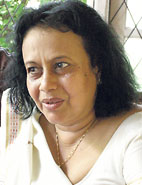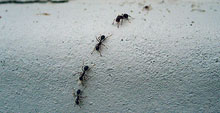It was news to me! With no scientific background to speak of, I’d never heard the word `pheromones’ before and the introduction I had to Professor Neelakanthi Ekanayake-Gunawardena from my son who had met her in Australia, mentioned only that she had carried out some interesting research into chemical signals given out by insects.
Unprepared as I was for the “unprofessor-like” appearance of the youthful, sweet-faced woman who greeted me I was fascinated by her explanation of the phenomenon of `pheromones’ .
 |
| Prof. Neelakanthi |
Prof. Neelakanthi’s thesis for her Ph.D in Organic Chemistry was on the “Synthesis of Some Insect Pheromones”. She has also published an illustrated book on this subject in Sinhala, which must undoubtedly be a boon to students of Chemistry. She started off by mentioning the long trails of ants one sees, a common sight in my own house, and surprised me with the information that they followed the chemical scent or pheromone left by the lead ant. Each species has its own pheromone, she told me, from ants, moths & butterflies to lobsters, to dogs, pigs, cattle and elephants!
Apparently, the first pheromone was discovered in 1870 by the great French scientist and entomologist, J.H. Fabre. He had kept a Great Peacock Moth, a virgin female, in a cage in his study and in the night he heard the sound of a big whirring of wings. Fabre found about 100 male moths of the same species fluttering around the cage. After much investigation, Fabre finally concluded that it was a chemical signal from the caged female that lured male moths. “He has written a beautiful account of it,” enthused Prof. Neelakanthi. The chemistry of these signals was, however, revealed only much later in 1959, by a German Chemist, A. Butenendt.
“The olfactory sense of insects and animals is much more acute than in humans,” she said. “That is how all the dogs in a neighbourhood are drawn to a house in which there is a bitch and it also explains why dogs stop to smell the urine of other dogs as they walk along the road.”
Elephants also discharge the pheromone into urine, and lobsters into water. The mating of insects and animals is triggered off by pheromones and with the advent of synthesized pheromones, these are used as “attractants” or “lures” to increase breeding in pigs and in lobsters by those whose business is the pork or the lobster industry.
Neelakanthi, on her return to the University of Kelaniya after obtaining her PhD from the University of Southampton, England, decided to concentrate on something of practical value to us in Sri Lanka and other parts of Asia – the red weevil that plagues coconut trees, their larvae causing immense damage inside the trees. So the pheromone based synthesized lure perfected by her by combining the already known pheromone with some chemicals from the host palm -–the coconut tree - is now used to trap red weevils.
Neelakanthi said that 30 milligrams of the above mixture placed in a vial is hung inside a bucket of water that is, in turn, tied to the trunks of coconut trees. This mixture attracts the red weevils which drown in the water in their attempts to reach it. ‘This is certainly better than the old practice of pouring insecticides into the trees,” she said, “The chemist’s job is to produce pheromones in an exact manner.”
There is much speculation, Prof. Neelakanthi told me, about the possibilities of humans emitting pheromones and in fact the perfume industry has utilised high technology to manufacture certain fragrances that they claim have “lures” which greatly enhance sex appeal.
 |
| Following the leader: A common sight among ants |
But many scientists dispute these claims. She mentioned as a fact that humans respond unconsciously to pheromones and that the responses are physiological rather than behavioural. It has been found that when women live together in hostels over a period of time, their menstruation times get synchronised. Also that, almost mysteriously, men’s under-arm secretions have an effect on women’s ovulation! The professor also spoke of the bonding that instantly occurs between a mother and her new-born as being undoubtedly due to smell and that there might be a pheromone involved.
Neelakanthi had her school education at Maliyadeva Girls’ College in her hometown of Kurunegala. She did her first degree, Chemistry Special, at Peradeniya University. It was while doing research there under Prof. G.P. Wannigama that she first became interested in research. The animation with which she talks of it left me in no doubt that she has found her métier. She has won many awards, prizes and fellowships in the course of her career, but she said the one she particularly cherishes is her very first award in 1995, from the Ceylon Institute of Chemistry which gave her the Chandrasena Memorial Award “for the outstanding contribution of an original nature in the field of Organic Chemistry.” (Prof. J.P.C. Chandrasena was the first Professor of Chemistry, University of Ceylon). Incidentally, this was for her work on “Identification of a Chemical Attractant system for the Monitoring/control of the coconut pest, `Rhynchophorous Ferrugineus’ in Sri Lanka” (the red weevil in common parlance).
In 1996 she won a National Award for Inventions, Sri Lanka, when she obtained the first prize for her invention on the “attractant system for the red weevil”. In 1997 she was awarded the First Prize of the Swiss Trade Promotion Office for `Woman Inventors from Developing Countries’ and a Gold-plated Medal from the Exhibition of Inventions, Geneva. Neelakanthi is a Fellow of the National Academy of Science, Sri Lanka, and of the International Union of Pure and Applied Chemistry. She has also been awarded the Humboldt fellowship from Germany. In 2004 she was appointed Professor of Chemistry at Kelaniya University. She has numerous scientific publications to her name, many of them on Synthesis, or on Chemical Ecology.
Presently, she is considering a permanent move to Adelaide in South Australia where her husband preceded her when their daughter, Upuli, who first qualified as a Nutritionist and worked as such for a time, switched to medical studies. Mr. Gunawardena too has a Ph.D in Chemistry, but had later switched to Computer Science and started his own business in that line. Their son is a Mechanical Engineer.
“When I am in Adelaide, my chief occupation is cooking meals, washing up, cleaning and tidying and taking out the garbage,” Neelakanthi said with a smile. However, she did admit that she is working part-time at Flinders University where her focus will be to synthesise the pheromone of the black beetle which, she says, does even more damage to coconut trees than its red counterpart.
This pheromone is very expensive and therefore not used in Sri Lanka, but a low cost pheromone formulation has already been developed by Neelakanthi with research funds from the National Science Foundation of Sri Lanka. She also has plans to write another book about new findings with regard to pheromones, in English and Sinhala.A very likeable personality, one who doesn’t talk down to ignorant lay-persons like this interviewer, Prof. Neelakanthis comes across as an endearing human being as well as an academic of distinction. |


